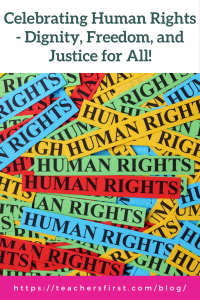My humanity is bound up in yours, for we can only be human together.
– Desmond Tutu, South African Theologian and Human Activist
In December, we celebrate Universal Human Rights Month, which honors the Universal Declaration of Human Rights (UDHR), an international document adopted by the General Assembly of the United Nations on December 10, 1948. The Universal Declaration states basic rights and fundamental freedoms to which all human beings are entitled. This year’s Human Rights Day also launched a year-long campaign to celebrate the upcoming 75th anniversary of the UDHR on December 10, 2023.
Discussing and teaching students about human rights can feel challenging. These are tough conversations, but they are also important. Your classroom provides a valuable opportunity to build a community that will instill a sense of safety and belonging in all students.
Celebrating Universal Human Rights Month is just as important as any other holiday. So how do we teach human rights to students? Here are a few starting points:
Explore the Universal Declaration
The Universal Declaration, written 74 years ago, isn’t usually reviewed in schools, but the following resources can help you and your students dive into it.
- We Are All Born Free: The Universal Declaration of Human Rights in Pictures by Amnesty International is a great read-aloud to share with younger learners to start your discussion on human rights. In addition, you can use a collaborative digital bulletin board like Padlet (reviewed here) or Jamboard (reviewed here) to create a class KWL before and after you read the book.
- The illustrated edition of the Universal Declaration of Human Rights is an e-book produced in partnership between artist Yacine Ait Kaci the United Nations, and others. You can easily record a screencast reading this book and create an Edpuzzle (reviewed here) video lesson that can be done synchronously as a class in Edpuzzle Live Mode.
- This Infographic of the UDHR from Zen Pencils beautifully illustrates all 30 basic rights and fundamental freedoms of the UDHR in one image. Allow students to look at the details of the infographic and share wonderings with you. You can even have students respond to guided discussion prompts in Flip (reviewed here) and encourage a digital classroom discussion.
Use Books to Explore the Issues of Human Rights Around the World
- Epic! (reviewed here) has various human rights book collections created by Epic! Teachers.
- Curriconnects Book List – Slavery – This TeachersFirst collection includes fiction, historical fiction, and informational text. Use these books to help students understand this challenging topic more deeply.
- Cobb County Public Library’s Universal Human Rights Month Booklist – Carefully curated and arranged by type, this visually appealing list includes book covers linked to descriptions in their catalog. Use this insightful list to familiarize yourself with options for inclusion in your classroom.
Let Your Students Take the Lead
There’s no one way to teach this challenging subject. Some of you may have done a single lesson plan on December 10, while others might be completing a month-long unit. Regardless of your approach, I invite you to let your students take the reins. Provide them with a foundation on the subject and then see where they would like to go with this topic. You can guide them as you encourage them to lead with curiosity. You might even encourage them to learn what steps they can take to help protect the rights of all humans on this planet.
I hope you’ll bring this vital topic to the forefront of your classroom this December. Be sure to let us know what you and your students learn in the comments below!


